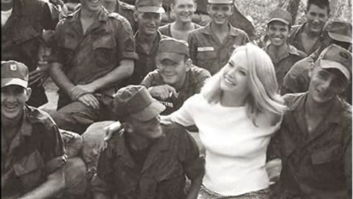
I’ve always been a fan of the movies. From seeing them to even having little bit parts in a couple of movies. This photo is from the 1988 Spanish feature length movie “The Ages of Lulu” and my entire three days of filming cut to nothing but the lead actress pulling out a photo with me in it in the movie. I’m in the center wearing my old 97.5 WONE jacket from my “rock jock days.”
As a kid, I was fortunate to work at a local origination cable TV station, the local commercial radio stations, and even our town theater, which was a 1930s single-screen theater that held over 800 people. The theater was The Bexley, and it was built at the end of the vaudeville days around 1930, so it actually had a stage, foot lights and stage lights, though in 1980 it was just showing movies. I’d sell tickets prior to showtime, then run upstairs and become projectionist. I learned with carbon-arc projectors (basically using welding rods to produce light with the help of a rectifier), two projectors (with change-overs every 20 or so minutes), and a tall tube-filled RCA amplifier for our James B. Lansing Voice of the Theater speaker on the stage behind the perforated screen. It was a blast working at the theater! We filled the place with the $1 matinees on Saturday and Sunday at noon. I remember a line for 3 blocks for a $1 “Muppet Movie” showing!
For this Off the Beaten Path, let’s go to the movies.
Cecil B. DeMille
Throughout film history, we’ve had some big names in movie making. Edison was one of our first in the U.S. (along with the Lumiere brothers), then names like D.W. Griffith all the way up to George Lucas, Ron Howard, Quentin Tarantino and so many others. Here’s a story of an archaeological dig that is related to film and the 1923 movie, “The Ten Commandments.”
More on Movie History
Here’s an interesting website for getting the “skinny” on history in a hurry. The History Cooperative has a “short history of nearly everything,” and from that website comes the History of the Hollywood Movie Industry.
Everything and Everyone in Every Movie
I can’t imagine that everyone and their brother isn’t familiar with one of my favorite movie research websites. I’ve mentioned it here before, but with the theme of this OTBP being movies, I’d be remiss to not mention the Internet Movie Database (or IMDb). This site really is the definitive site for not only movies, but television shows and series as well. If you are doing research or just looking for some movie worth watching, it will probably tell you what you want to know (and a whole lot more if you’re interested).
Evolution of Cinema
Since we’re talking about movies, here’s a link to a lengthy video which explores the evolution of cinema starting with the earliest films still in existence and takes us all the way up through the end of 2017
Technology in Film
I remember working on my corollary sequence at Ohio University in the film school. Ohio U. has a great M.F.A. program, but I was able to sneak in that department while working on my B.S. in Communications. I had a great interest in film and sweet-talked some cool professors into letting me into some of their more technical classes like Avid editing with Jack Wright and film sound with John Butler. Back in the late ’90s, when I spoke of film eventually being shot with the new high-def video gear, it was “blasphemy.”
Folks in the film world really didn’t see that because film had such a different captivation to the human mind and soul than that “sterile video stuff.” In just a few years, Lucas was moving onto “digital cinema” and the world transitioned. With some wonderful digital technology specifically intended for the 24 fps “film look,” plus incredible digital animations and computer-generated images (no longer using technology like Disney’s Multiplane Camera), the industry made the transition. Here’s a great link to the seven biggest technology breakthroughs tied to film making.
Digital Projection
In my work as chief video engineer for New World Symphony, I’ve been migrating the video systems and projection systems from 4K over to UHD (Ultra High Def). In the cinema world, UHD is called 4K. The real difference between the two (UHD and 4K) is really based on aspect ratio. UHD maintains HDTV’s 16:9 aspect ratio, where 4K is slightly wider (about 2:1) in resolution. As movies went from film to digital, projection changed to digital and it became possible to stop shipping heavy film containers and switch to shipping movies on hard drives. Theaters now can do digital transfers with an encoded copyguard (i.e. DRM /Digital Rights Management) which protects them from copying, and theaters can even put on special programs live (like concerts, plays, and about anything related to the arts).
Like video’s transition from HD to UHD, film is going from 2K to 4K. Though this information is about eight years-old, it’s a good discussion on how movies are distributed today.
Here’s an excellent video related to the technology directly related to projecting the image — the digital projectors.
This link actually is great for showing the entire system working together including the cinema server to the projection system and audio.
And Finally …
Recently, my wife, daughters and I went to an art show in Boca Raton, Fla. I noticed a local movie theater near where we were and a theater name I that wasn’t familiar with called iPic Theaters. As a movie fan, I go to a lot of movies and have been to Regal, Universal, Cinemark and most of the big theater chains. I could give you a review on what some do very well and what some aren’t so good at, but that’s another story. I peeked in the windows of this theater which didn’t resemble the big chains and it appeared to be very different — very “upscale.” After a little research, I found that the chain is relatively new and very small with only 13 cinemas (all multiscreen) across the country.
What makes me mention this is how very unique the chain is. The auditoriums (screens) appear to have anywhere from 30 to 80 seats. The seats are all “recliner sized” or even “love seat sized” with small tables. The concession stands have wood burning pizza ovens, and the actual theaters have bars and restaurants. Here’s link to a very unique movie theater chain called iPic Theaters.
If you stumble across a good or unusual website that might be of interest, please don’t hesitate to send me the link and any info you might have about it. My email address is [email protected].












